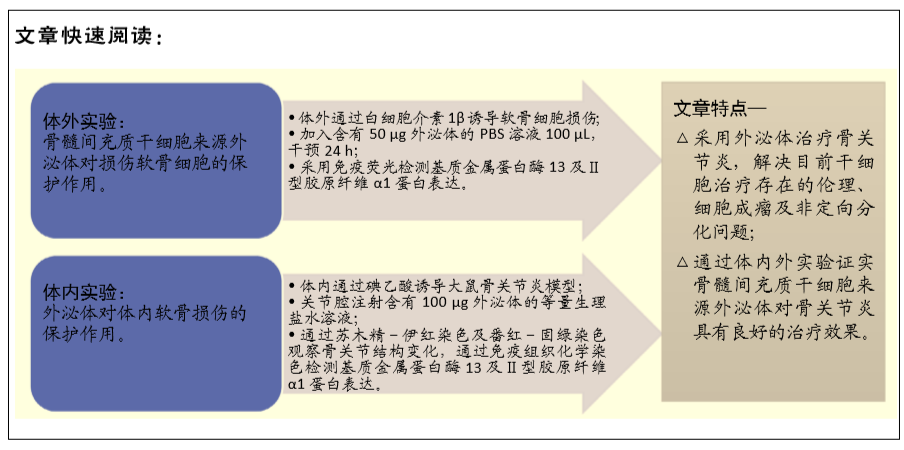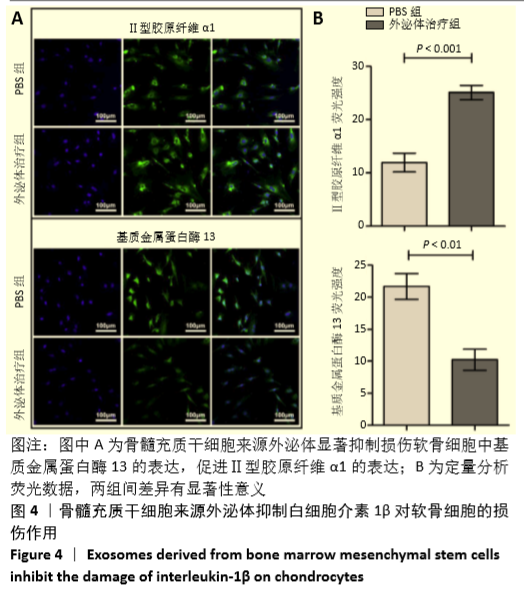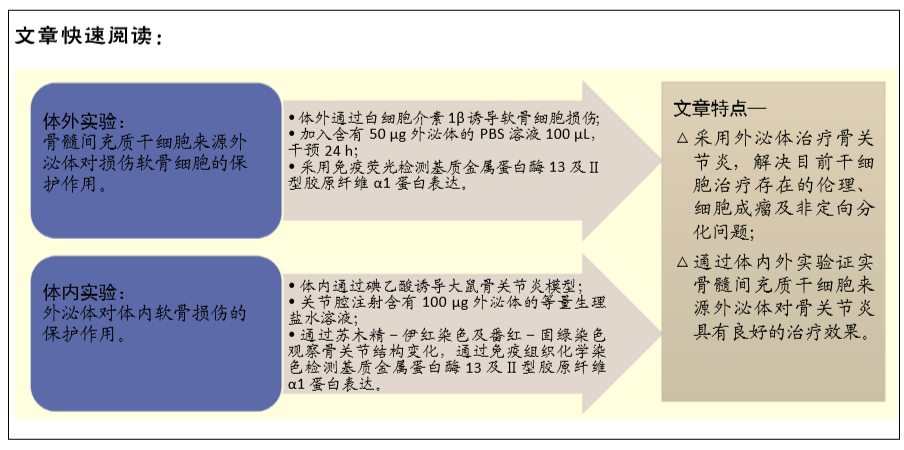[1] 陆文忠,杨现莉,韦喜.外泌体治疗骨关节炎作用机制的研究进展[J].右江民族医学院学报,2019,41(3):342-345,355.
[2] TSUNO H, ARITO M, SUEMATSU N, et al. A proteomic analysis of serum-derived exosomes in rheumatoid arthritis. BMC Rheumatol. 2018;2:35.
[3] WANG R, JIANG W, ZHANG L, et al. Intra-articular delivery of extracellular vesicles secreted by chondrogenic progenitor cells from MRL/MpJ superhealer mice enhances articular cartilage repair in a mouse injury model. Stem Cell Res Ther. 2020;11(1):93.
[4] WANG R, XU B, XU H. TGF-β1 promoted chondrocyte proliferation by regulating Sp1 through MSC-exosomes derived miR-135b. Cell Cycle. 2018;17(24):2756-2765.
[5] 罗欣,余丽梅.外泌体在间充质干细胞治疗骨性关节炎中的作用:新策略与新思路[J].中国组织工程研究,2018,22(1):140-145.
[6] 周晓雯,李鹰扬,刘政,等.外泌体在骨性关节炎发病机制中的研究进展[J].中国骨科临床与基础研究杂志,2018,10(6):361-366.
[7] 王思捷,廖淑珍,招春飞,等.间充质干细胞源外泌体治疗类风湿性关节炎动物模型和临床研究进展[J]. 中国比较医学杂志,2019, 29(3):109-112.
8] 朱海,刘璠.间充质干细胞来源外泌体在骨性关节炎中的应用[J].江苏医药,2017,43(16):1181-1185.
[9] WITHROW J, MURPHY C, LIU Y, et al. Extracellular vesicles in the pathogenesis of rheumatoid arthritis and osteoarthritis. Arthritis Res Ther. 2016;18(1):286.
[10] WU J, KUANG L, CHEN C, et al. miR-100-5p-abundant exosomes derived from infrapatellar fat pad MSCs protect articular cartilage and ameliorate gait abnormalities via inhibition of mTOR in osteoarthritis. Biomaterials. 2019;206:87-100.
[11] WU X, WANG Y, XIAO Y, et al. Extracellular vesicles: Potential role in osteoarthritis regenerative medicine. J Orthop Translat. 2019;21:73-80.
[12] 董贵俊,闫前,吴燕,等.间充质干细胞来源外泌体在运动调节骨关节炎中的作用[J].体育科学,2020,40(1):89-97.
[13] ASGHAR S, LITHERLAND GJ, LOCKHART JC, et al. Exosomes in intercellular communication and implications for osteoarthritis. Rheumatology (Oxford). 2020;59(1):57-68.
[14] CARPI S, SCODITTI E, MASSARO M, et al. The Extra-Virgin Olive Oil Polyphenols Oleocanthal and Oleacein Counteract Inflammation-Related Gene and miRNA Expression in Adipocytes by Attenuating NF-κB Activation. Nutrients. 2019;11(12):2855.
[15] CHANG YH, WU KC, HARN HJ, et al. Exosomes and Stem Cells in Degenerative Disease Diagnosis and Therapy. Cell Transplant. 2018; 27(3):349-363.
[16] 李培霆,李龙.类风湿关节炎相关外泌体及其治疗作用的研究进展[J].山东医药,2018,58(45):111-113.
[17] 陈桂婷,董甜甜,余婕,等.外泌体及miRNA与类风湿性关节炎[J].生命的化学,2019,39(5):955-960.
[18] 邓雷弘,龚芸,黄晓林,等.外泌体在类风湿性关节炎发病机制中的研究进展[J].中国医学科学院学报,2019,41(4):556-561.
[19] COSENZA S, RUIZ M, MAUMUS M, et al. Pathogenic or Therapeutic Extracellular Vesicles in Rheumatic Diseases: Role of Mesenchymal Stem Cell-Derived Vesicles. Int J Mol Sci. 2017;18(4):889.
[20] COSENZA S, RUIZ M, TOUPET K, et al. Mesenchymal stem cells derived exosomes and microparticles protect cartilage and bone from degradation in osteoarthritis. Sci Rep. 2017;7(1):16214.
[21] D’ARRIGO D, ROFFI A, CUCCHIARINI M, et al. Secretome and Extracellular Vesicles as New Biological Therapies for Knee Osteoarthritis: A Systematic Review. J Clin Med. 2019;8(11):1867.
[22] DILSIZ N. Role of exosomes and exosomal microRNAs in cancer. Future Sci OA. 2020;6(4):FSO465.
[23] REZA-ZALDIVAR EE, HERNÁNDEZ-SAPIÉNS MA, GUTIÉRREZ-MERCADO YK, et al. Mesenchymal stem cell-derived exosomes promote neurogenesis and cognitive function recovery in a mouse model of Alzheimer’s disease. Neural Regen Res. 2019;14(9):1626-1634.
[24] 苏永蔚,周山健,肖大伟,等.负载miRNA-27b的BMSCs来源的外泌体治疗实验性骨关节炎[J].中国矫形外科杂志,2019,27(8):726-734.
[25] ZHANG R, MA J, HAN J, et al. Mesenchymal stem cell related therapies for cartilage lesions and osteoarthritis. Am J Transl Res. 2019;11(10):6275-6289.
[26] ZHAO Y, XU J. Synovial fluid-derived exosomal lncRNA PCGEM1 as biomarker for the different stages of osteoarthritis. Int Orthop. 2018; 42(12):2865-2872.
[27] 高坤,朱文秀,曹亚飞.类风湿关节炎和骨关节炎发病及治疗中的外泌体[J].中国组织工程研究,2018,22(36):5858-5864.
[28] XIE F, LIU YL, CHEN XY, et al. Role of MicroRNA, LncRNA, and Exosomes in the Progression of Osteoarthritis: A Review of Recent Literature. Orthop Surg. 2020;12(3):708-716.
|








